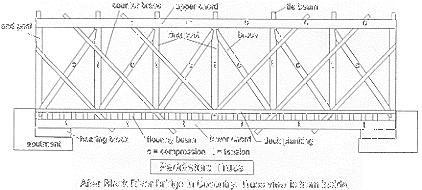paddle
The Paddleford Truss
From Spanning Time: Appendix C - The Bridge Truss
Peter Paddleford (1785-1859) was a bridge builder from Littleton, New Hampshire. He was a
user of the Long truss, designed and patented by Colonel Stephen Long in 1830. He created his
own truss by modifying the Long truss, stiffening it with a system of interlocking counterbraces.
His work was challenged by the holders of the Long Truss patents because of its similarities.

Jan Lewandoski, wooden bridge builder and restorer, explains how the Paddleford truss works and how it differs from Long's truss: "The Paddleford truss superficially resembles the Long truss. They both use a parallel chord system with vertical posts, and they both use braces and counterbraces. But the designers each had something different in mind. Long designed his truss to implement his pre-stressing idea while Paddleford tried to make the braces work both in compression and tension by having the braces lap over all of the frame members. He tried to use wood like people later used iron rods. It's hard to make a tension joint with wood unless you have a lot of distance to do it in. It is complicated joinery."
Paddleford did it with the counterbraces by running them through the series of tight-fitting channels across members that are under loading stresses. The stresses tend to re-align the truss members, causing them to lock onto the counterbraces.
While the Paddleford truss design was never patented because of court challenges threatened by the owners of the Long Truss patent, it was widely used, especially in New Hampshire where many exist today. It was also popular in Orleans and Caledonia counties where Vermont's last two Paddleford bridges stand.
Joe Nelson, P.O Box 267, Jericho, VT 05465-0267, jcnelson@together.net
Text this page Copyright © 1997, Joseph C. Nelson
Photographs this page Copyright ©, 1999, Joseph C. Nelson
Illustrations this page Copyright ©, 1997, Joseph C. Nelson
This file revised April 9, 2000 (10:31AM)